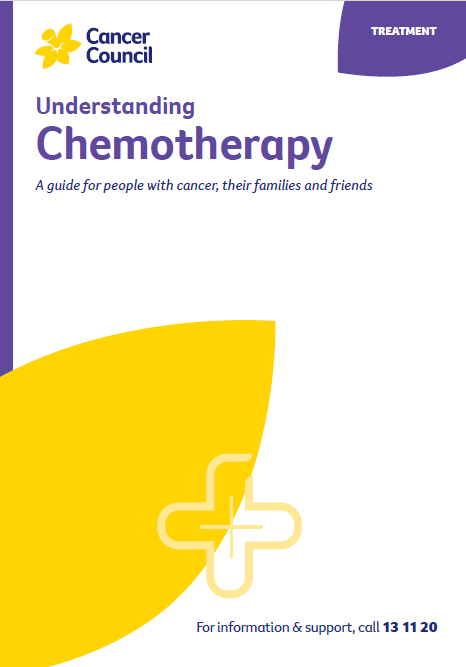- Home
- Acute lymphoblastic leukaemia (ALL)
- Treatment
- Chemotherapy
Chemotherapy for ALL
Chemotherapy uses drugs to kill leukaemia cells or slow their growth.
Learn more about:
- Overview
- Side effects of chemotherapy treatment
- Intrathecal chemotherapy
- Phases of chemotherapy treatment for ALL
- Video: What is chemotherapy?
Overview
Treatment protocols set out which drugs to have, how much and how often (see eviq.org.au for more information). However, your haematologist may need to tailor the drugs to your individual situation.
For acute lymphoblastic leukaemia (ALL), chemotherapy is usually given in 3 main phases over 1–3 years. The first 2 phases (induction and consolidation) involve high-dose chemotherapy, so most people need to stay in hospital for several weeks.
You may have a bone marrow biopsy or lumbar puncture during chemotherapy to see how the treatment is working.
Side effects of chemotherapy
As well as killing leukaemia cells, the drugs may also may also damage healthy fast-growing cells, such as hair follicles, blood cells, and cells inside the mouth or bowel.
This can cause:
- hair loss
- high risk of infection
- mouth ulcers
- nausea
- vomiting
- constipation or diarrhoea.
For more on this, see Managing side effects for ALL and Chemotherapy.
Intrathecal chemotherapy
Some people with ALL have leukaemia cells in the fluid around the brain and spinal cord (cerebrospinal fluid) at the time of diagnosis. Leukaemia cells may also spread to the cerebrospinal fluid after remission.
Chemotherapy drugs given into a vein or as tablets cannot get into the cerebrospinal fluid, so the drugs need to be injected directly into the spinal column using a lumbar puncture. This is called intrathecal chemotherapy.
After the procedure, you may have to lie on your back for a short time to help prevent a headache. Your doctor will discuss other possible side effects with you before the procedure.
Phases of chemotherapy treatment for ALL
Chemotherapy for ALL is generally given in three phases:
Depending on the features of the leukaemia, you may have some or all of these phases of treatment.
You will have several chemotherapy drugs in different combinations in each phase of treatment. Some are given into a vein (intravenously) and others are given as a tablet.
The entire process can take 1–3 years, with the maintenance phase taking up most of the treatment time.
1. Induction chemotherapy
- The aim of induction chemotherapy is to bring about (induce) remission. This means leukaemia cells are no longer found in bone marrow samples, the normal cells return, and blood counts become normal.
- You’ll have an intensive course of 3–4 drugs given at frequent intervals over 1–4 weeks. You’ll need to stay in hospital for 2–5 weeks.
- The drugs are often given through a central venous access device (CVAD) inserted into a vein in your upper arm or chest. The CVAD will be inserted under a general or local anaesthetic, and then left in place throughout the induction phase. The CVAD can also be used to take blood samples for testing.
- As the leukaemia cells die, they release a chemical called uric acid. This may build up and damage the kidneys, but can be controlled with medicine and intravenous fluids.
- You will have a bone marrow biopsy to check how well the treatment has worked. If no leukaemia cells are seen, this is called remission.
- If the biopsy shows leukaemia cells in the bone marrow, you may be given more chemotherapy, at similar or higher doses.
2. Consolidation chemotherapy
- Consolidation chemotherapy is also called post-remission therapy or intensification. It is given after remission is achieved.
- The aim is to kill any cells that may have survived the induction chemotherapy and to stop ALL coming back and/or spreading to the central nervous system.
- You will have several cycles of high-dose chemotherapy over 6–12 months.
- The type of chemotherapy drugs you are offered will depend on your risk of relapse.
- Depending on the types of drugs used, you will either visit the hospital for treatment as an outpatient or stay in hospital for several nights.
- If your chance of relapse is high, you may be offered further induction chemotherapy or a stem cell transplant
3. Maintenance chemotherapy
- Maintenance chemotherapy is commonly given after consolidation chemotherapy has finished. It will not be needed if you have a stem cell transplant.
- The aim is to increase how long you are in remission and prevent the leukaemia from coming back.
- You will take chemotherapy tablets either daily or weekly. You may also have intravenous chemotherapy and/or be offered steroids.
- This maintenance phase usually lasts between 18 months and 2 years.
- Maintenance chemotherapy is usually given as an outpatient. However, you may need to stay in hospital for some types of chemotherapy drugs.
→ READ MORE: CAR T-cell immunotherapy
Video: What is chemotherapy?
Watch this short video to see Medical Oncologist Prof Fran Boyle explain more about the role of chemotherapy, how you get it, and possible side effects.
More resources
Dr Jonathan Sillar, Haematologist, Calvary Mater Newcastle (clinical review); Dr Scott Dunkley, Haematologist, Royal Prince Alfred Hospital and Chris O’Brien Lifehouse; Sharon Frazer, Consumer; Dr Robin Gasiorowski, Staff Specialist, Haematology, Concord Hospital; Prof Angela Hong, Radiation Oncologist, Chris O’Brien Lifehouse, and Clinical Professor, The University of Sydney; Yvonne King, 13 11 20 Consultant, Cancer Council NSW; Heather Mackay, Clinical Nurse Consultant – Haematology, Westmead Hospital; Katelin Mayer, Clinical Nurse Consultant, Cancer Outreach Team, Nelune Comprehensive Cancer Centre.
View the Cancer Council NSW editorial policy.
View all publications or call 13 11 20 for free printed copies.

